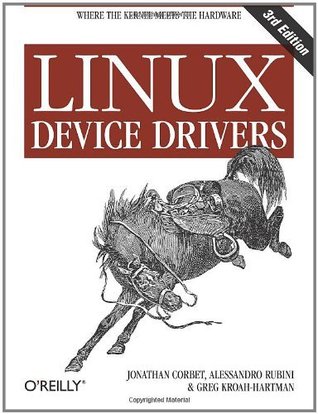Kindle Notes & Highlights
Started reading
February 18, 2022
In other words, your drivers should almost certainly be using alloc_chrdev_region rather than register_chrdev_region.
For normal use of the driver, this is hardly a problem, because once the number has been assigned, you can read it from /proc/devices.[
The best way to assign major numbers, in our opinion, is by defaulting to dynamic allocation while leaving yourself the option of specifying the major number at load time, or even at compile time.
Most of the fundamental driver operations involve three important kernel data structures, called file_operations, file, and inode.
The file_operations structure is how a char driver sets up this connection. The structure, defined in <linux/fs.h>, is a collection of function pointers.
We can consider the file to be an “object” and the functions operating on it to be its “methods,” using object-oriented programming terminology to denote actions declared by an object to act on itself. This
Each field in the structure must point to the function in the driver that implements a specific operation, or be left NULL for unsupported operations. The exact behavior of the kernel when a NULL pointer is specified is different for each function,
a number of parameters include the string _ _user. This annotation is a form of documentation, noting that a pointer is a user-space address that cannot be directly dereferenced. For normal compilation, _ _user has no effect, but it can be used by external checking software to find misuse of user-space addresses.
This declaration uses the standard C tagged structure initialization syntax. This syntax is preferred because it makes drivers more portable across changes in the definitions of the structures and, arguably, makes the code more compact and readable. Tagged initialization allows the reordering of structure members; in some cases, substantial performance improvements have been realized by placing pointers to frequently accessed members in the same hardware cache line.
The value in filp->f_op is never saved by the kernel for later reference; this means that you can change the file operations associated with your file, and the new methods will be effective after you return to the caller.
private_data is a useful resource for preserving state information across system calls and is used by most of our sample modules.
There can be numerous file structures representing multiple open descriptors on a single file, but they all point to a single inode structure.
as soon as cdev_add returns, your device is “live” and its operations can be called by the kernel. You should not call cdev_add until your driver is completely ready to handle operations on the device.
The only real operation performed on the device is truncating it to a length of 0 when the device is opened for writing. This is performed because, by design, overwriting a scull device with a shorter file results in a shorter device data area. This is similar to the way opening a regular file for writing truncates it to zero length.
The close system call executes the release method only when the counter for the file structure drops to 0, which happens when the structure is destroyed. This relationship between the release method and the close system call guarantees that your driver sees only one release call for each open.
two core functions used to manage memory in the Linux kernel. These functions, defined in <linux/slab.h>, are: void *kmalloc(size_t size, int flags); void kfree(void *ptr);
You should never pass anything to kfree that was not obtained from kmalloc. It is, however, legal to pass a NULL pointer to kfree.
Depending on which architecture your driver is running on, and how the kernel was configured, the user-space pointer may not be valid while running in kernel mode at all. There may be no mapping for that address, or it could point to some other, random data.
Even if the pointer does mean the same thing in kernel space, user-space memory is paged, and the memory in question might not be resident in RAM when the system call is made. Attempting to reference the user-space memory directly could generate a page fault, which is something that kernel code is not allowed to do.
The pointer in question has been supplied by a user program, which could be buggy or malicious. If your driver ever blindly dereferences a user-supplied pointer, it provides an open doorway allowing a user-space program to access or overwrite memory anywhere in the system.
This happens, for example, when the page must be retrieved from swap space. The net result for the driver writer is that any function that accesses user space must be reentrant, must be able to execute concurrently with other driver functions, and, in particular, must be in a position where it can legally sleep.
If some data is transferred correctly and then an error happens, the return value must be the count of bytes successfully transferred, and the error does not get reported until the next time the function is called. Implementing this convention requires, of course, that your driver remember that the error has occurred so that it can return the error status in the future.
Although kernel functions return a negative number to signal an error, and the value of the number indicates the kind of error that occurred (as introduced in Chapter 2), programs that run in user space always see -1 as the error return value. They need to access the errno variable to find out what happened.
If your driver does not supply methods to handle the vector operations, readv and writev are implemented with multiple calls to your read and write methods. In many situations, however, greater efficiency is acheived by implementing readv and writev directly.


